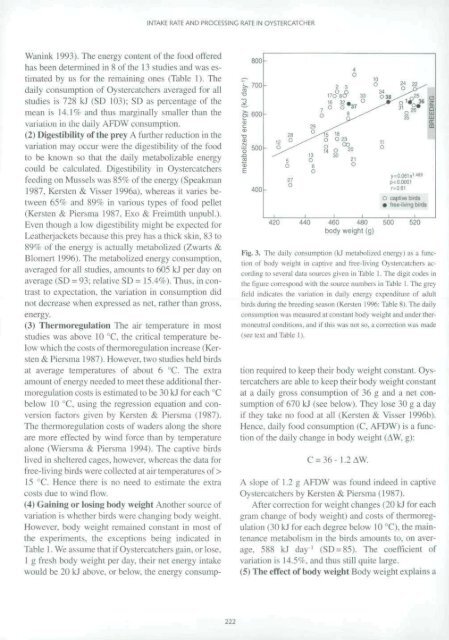waders and their estuarine food supplies - Vlaams Instituut voor de ...
waders and their estuarine food supplies - Vlaams Instituut voor de ...
waders and their estuarine food supplies - Vlaams Instituut voor de ...
You also want an ePaper? Increase the reach of your titles
YUMPU automatically turns print PDFs into web optimized ePapers that Google loves.
Wanink 1993). The energy content of the <strong>food</strong> offered<br />
has been <strong>de</strong>termined in 8 of ihe 13 sludies <strong>and</strong> was estimated<br />
by us for the remaining ones (Table I). The<br />
daily consumption of Oystercatchers averaged for all<br />
studies is 728 kJ (SD 103); SD as percentage of the<br />
mean is 14.1*36 <strong>and</strong> thus marginally smaller than the<br />
variation in the daily AFDW consumption.<br />
(2) Digestibility of the prey A further reduction in the<br />
variation may occur were the digestibility of the <strong>food</strong><br />
to be known so thai the daily metabolizable energy<br />
could be calculated. Digestibility in Oystercatchers<br />
feeding on Mussels was 85'< of the energy (Speakman<br />
1987. Kersicn & Visser 1996a). whereas it varies between<br />
659! <strong>and</strong> 8991 in various types of <strong>food</strong> pellet<br />
(Kersten & Piersma 1987. Exo & Freimiith unpubl).<br />
Even though a low digestibility might be expected for<br />
Leatherjackets because this prey has a thick skin. 83 to<br />
89% of the energy is actually metabolized (Zwarts &<br />
Blomen 1996). The metabolized energy consumption.<br />
averaged for all studies, amounts to 605 kJ per day on<br />
average (SD = 93; relative SD = 15.4%). Thus, in contrast<br />
to expectation, the variation in consumption did<br />
not <strong>de</strong>crease when expressed as net, rather than gross.<br />
energy.<br />
(3) Thermoregulation The air temperature in most<br />
studies was above 10 °C. the critical temperature below<br />
which the costs of thermoregulation increase (Kersten<br />
& Piersma 1987). However, two Studies held birds<br />
at average temperatures of about 6 °C. The extra<br />
amount of energy nee<strong>de</strong>d to meet these additional thermoregulation<br />
costs is estimated to be 30 kJ for each °C<br />
below 10 C. using the regression equation <strong>and</strong> conversion<br />
factors given by Kersten & Piersma (1987).<br />
The thermoregulation costs of <strong>wa<strong>de</strong>rs</strong> along the shore<br />
are more effected by wind force than by temperature<br />
alone iWieisma & Piersma 1994). The captive birds<br />
lived in sheltered cages, however, whereas the data for<br />
free-living birds were collected at air temperatures of ><br />
15 °C. Hence there is no need to estimate the extra<br />
COStS due to wind flow.<br />
(4) Gaining or losing body weight Another source of<br />
variation is whether birds were changing body weight.<br />
However, body weight remained constant in most of<br />
the experiments, the exceptions being indicated in<br />
Table 1. We assume that if Oystercatchers gain, or lose.<br />
1 g fresh body weighl per day. <strong>their</strong> net energy intake<br />
would be 20 kJ above, or below, the energy consump-<br />
INTAKE RATE AND PROCESSING RATE IN OYSTERCATCHER<br />
222<br />
460 480<br />
body weight (g)<br />
rig. .1. The dailv consumption IkJ metabolized energy I as a func<br />
tion of body weighl in captive <strong>and</strong> free-living Oystercalchers ac<br />
cording to several dala sources given in Table I. The digit co<strong>de</strong>s in<br />
ihe figure correspond with the source numbers in Table I. The grey<br />
field indicates the variation in daily energy expenditure of adult<br />
birds during the breeding season I Kersten I'796: Table S). The daily<br />
eonsiiiiipiinn was measured al constant hixly weight <strong>and</strong> un<strong>de</strong>r ther-<br />
monculral conditions, <strong>and</strong> it Ihis was mu so. a correction was ma<strong>de</strong><br />
(see levl <strong>and</strong> Tahle I).<br />
lion required to keep <strong>their</strong> body weighl constant. Oystercaiclieis<br />
are able lo keep <strong>their</strong> body weight constant<br />
at a daily gross consumption of 36 g <strong>and</strong> a net consumption<br />
of 670 kJ (see below). They lose 30 g a day<br />
if they take no <strong>food</strong> at all (Kersten & Visser 1996b).<br />
Hence, daily fcxxl consumption (C, AFDW) is a function<br />
of ihe daily change in body weight (AW. g):<br />
C = 36-1.2 AW.<br />
A slope of 1.2 g AFDW was found in<strong>de</strong>ed in captive<br />
()v stercatchers by Kersten & Piersma 11987).<br />
After correction for weight changes (20 kJ for each<br />
gram change of body weight) <strong>and</strong> costs of thermoregulation<br />
(30 kJ for each <strong>de</strong>gree below 10 °C). the maintenance<br />
metabolism in the birds amounts to. on average.<br />
58S kJ day' (SD=85). The coefficient of<br />
variation is 14.5%, <strong>and</strong> thus still quite large.<br />
(5) The effect of body weight Body weight explains a

















